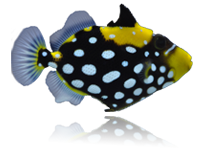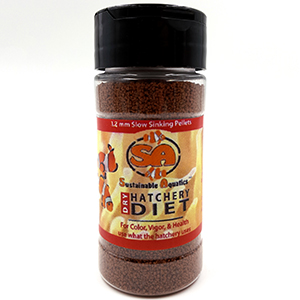Clown Triggerfish
- Species Information
- Scientific Name:Balistoides conspicillum
- Family:Balistide
- Temperament:Aggressive
- Maximum Size:1' 8"
- Ideal Tank Size:>300 gallons

The clown trigger, Balistoides conspicillum (Bloch & Schneider, 1801) is perhaps the most notorious of all triggerfish. Sought after for its unique coloration, dog-like personality, and impressive size, these fish make very entertaining pets if they are kept properly. It is best to acquire these fish at a small size because they usually recover faster from shipping, are easier to “train” when feeding, and have a better chance of remaining peaceful towards their tank mates. Triggerfish are carnivores and must be fed meaty foods, multiple times a day. At our Sustainable Islands project we feed our juvenile clown triggers our hatchery diet, brine, mysis, and krill. As they get older they can eat more substantial food such as squid, clams on the half shell, and lance fish or silversides. Triggers may be trained to eat food out of your hand and many can even be trained to do tricks. Naturally curious and always hungry, these fish may mistake your hand or arm for food so care should be taken when working in their tank. A large system is required to accommodate their size and adequate filtration is essential to ensure good water quality due to the large amount of waste they produce.
Physical Description– The appearance of clown triggers changes as they mature. As juveniles they have a black body with a yellow snout and back, white spots cover the majority of their body. As adults the yellow patches diminish and latticed pattern is present on their back. They have a horizontal white bar beneath their eye and yellow remains only on their mouth. Their white spots became much larger and less uniform in shape. Triggers will change their color slightly according to their mood and health so they may appear more or less vibrant on a given day.
Temperament– These fish are notorious for their highly aggressive personality. As juveniles, they will be compatible with most other fish, however as they grow, many of their tank mates may become prey. Do not house these fish with any small, peaceful, slow-moving fish. Similarily, do not house them with any invertebrates. They require aggressive tank mates such as groupers, large puffers, tangs, or angels, but they have even been known to attack lionfish, eels, and sharks. Choose tank mates carefully.
Size– Clown triggers can reach a maximum size of one foot eight inches. They require at least 200 gallons with ample swimming space and adequate filtration.
Diet– At our Sustainable Islands project we feed our juvenile clown triggers our Hatchery Diet, brine, mysis, and krill. As they get older they can eat more substantial food such as squid, clams on the half shell, and lance fish or silversides.
Distribution– Clown triggers have a fairly large range. They are found throughout the Indo Pacific, north to Japan, south to New Caledonia.







